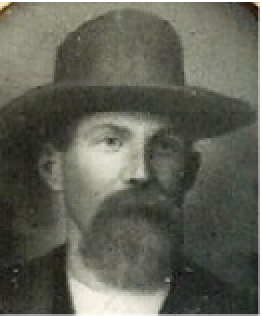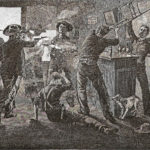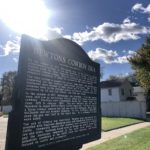NEWTON — The most famous of Old West shootouts took place some 1,000 miles west of here, outside the O.K. Corral in Tombstone, Arizona Territory. But that fracas pales in comparison to the mayhem unleased in Harvey County a decade earlier.
Known as the “Gunfight in Hide Park” or “Newton General Massacre,” the burst of gunfire on Aug. 20, 1871 left five men dead and briefly made Newton notorious across the country. Adding to the drama was the fact that the young man believed responsible for most of the bloodshed disappeared immediately afterward, never to be heard of again.
The massacre was part of a summer-long spree of violence that coincided with the arrival of the Atchison, Topeka & Santa Fe Railroad, which turned Newton into the terminus and cattle shipping point for the Chisholm Trail. Practically overnight, Newton grew from a village with a dozen homes and blacksmith’s shop into a bustling commercial center serving something like a thousand settlers and Texas cowboys. A strip of saloons and bawdy houses called “Hide Park” also sprung up — so named because its female citizens showed so much of their backsides (some later writers referred to it as “Hyde Park,” presumably out of delicacy). The area was located south of the railroad tracks and west of Main Street.
According to a history penned by Judge RWP Muse, an early civic leader, the first two saloon killings occurred that June. In early August, two more deaths followed. One of the latter was perpetrated by Mike McCluskie, an Irishman who’d been hired by local authorities to keep the peace during a railroad bond election. Instead, he shot down a drunken Texan named Billy Bailey who’d been hired for the same purpose.
Fearing retribution from Bailey’s Texas friends, McCluskie fled town by train to Florence in neighboring Marion County. But he returned a week later and visited a dance hall in Hide Park to gamble early on the morning of Aug. 20, a Sunday. About 2 a.m., four Texans entered the place. One of them, whose name was Hugh Anderson, shot McCluskie in the neck. Fatally wounded, McCluskie tried to return fire but his gun misfired.
At that point, another gunman opened fire on the Texans, hitting all four of them in addition to three unlucky bystanders. One of these bystanders, Jim Martin, ran out and fell dead in front of a saloon known as the Alamo. Another, a railroad brakeman named Patrick Lee, died of his wounds a few days later, as did two of the Texans, Billy Garrett and Henry Kearnes. Anderson, the original shooter, was gravely wounded and initially not expected to survive. The last Texan, James Wilkerson, and a third bystander, named Hickey, suffered less-severe wounds. By comparison, the gunfight at the O.K. Corral killed three men and wounded three others.
Unfortunately for Newton’s reputation, correspondents for several newspapers happened to be in town to cover the cattle drives. Instead, they spread news of the gun battle from coast to coast.
Despite the attention, the gunman who’d wreaked such havoc in the dance hall was never arrested or even named in contemporary newspaper accounts. One article, by a correspondent for the New York World, referred to him as “Nemesis.”
It wasn’t until 11 years later that Judge Muse, in “A History of Harvey County: 1871-1881,” gave him a name: Riley. Muse wrote that Riley was about 18 years at the time of the shootings, “quiet and inoffensive, and evidently dying of consumption.” Muse added that Riley was known as “McCluskie’s Shadow” because he “followed the railroad gunman around like a little dog that barked and snapped behind his master.” It’s unclear why, if Riley was so well known, he wasn’t named in newspaper accounts at the time.
An arrest warrant was issued for Anderson in McCluskie’s slaying. However, before it could be served, his father — a wealthy Texas cattleman — arrived in Newton and arranged for his escape. Muse and other residents helped with the scheme, fearing that Anderson’s arrest would spark more violence. According to Muse, the men carried Anderson on a litter down a dark cattle trail and placed him in a closet of a railroad car that was then locked. He was taken to Kansas City, where he recovered from his wounds.
The violence continued. In September, Deputy Sheriff Carlos King was gunned down in Hide Park. Altogether, Muse estimated a dozen homicides took place during Newton’s cowtown era.
But the massacre spurred residents to take steps to form a city government in an attempt to restore order. Before August was over, a mass meeting was held to nominate a mayor, judge, marshal and five councilmen. A jail was quickly erected and an ordinance enacted against the carrying of weapons. In February 1872, Newton incorporated as a city. Not long after, the city passed a law prohibiting the driving of large animals through Newton.
Its days as a booming cowtown would have been numbered anyway. The railroad reached Wichita in 1872 and that young town became the shipping point for the Chisholm Trail — and experienced much the same type of violence as Newton, though not on the scale of the Gunfight in Hide Park. Indeed, Wichita’s best-known early outlaw — saloon keeper and gambler “Rowdy Joe” Lowe — simply moved his operation from Newton to Wichita.
For the most part, Newton has downplayed its bloody beginning. Unlike Wichita’s Old Cowtown Museum and Dodge City’s Boot Hill Museum, for instance, Newton doesn’t regularly stage simulated Wild West gunfights.
Kristine Schmucker, curator of the Harvey County Historical Museum, said some people think the influence of Mennonites in the county had something to do with that. But Schmucker, who is Mennonite, doubts that’s the case.
“Those early city leaders were so appalled at what had happened that they wanted it to be gone,” she said. “It was never celebrated. It never caught on.”
Muse, the civic leader and historian, was probably speaking for many residents when he wrote:
“It is an old saying, that a bad beginning insures a good ending, and if this be true, then will the infamous character, which the town justly earned, in the early days, fore-shadow an after career of unexampled greatness and prosperity.”
This article relies heavily on research by Kristine Schmucker, curator of the Harvey County Historical Museum in Newton. For more information, visit hchm.org.











